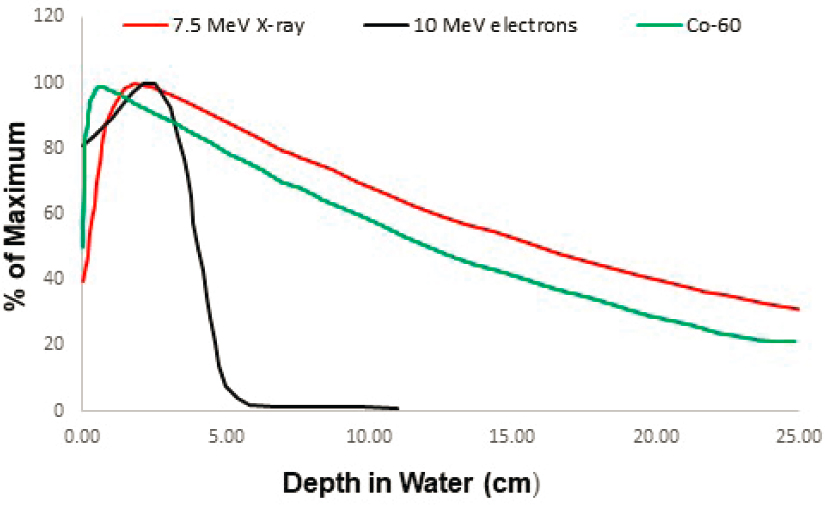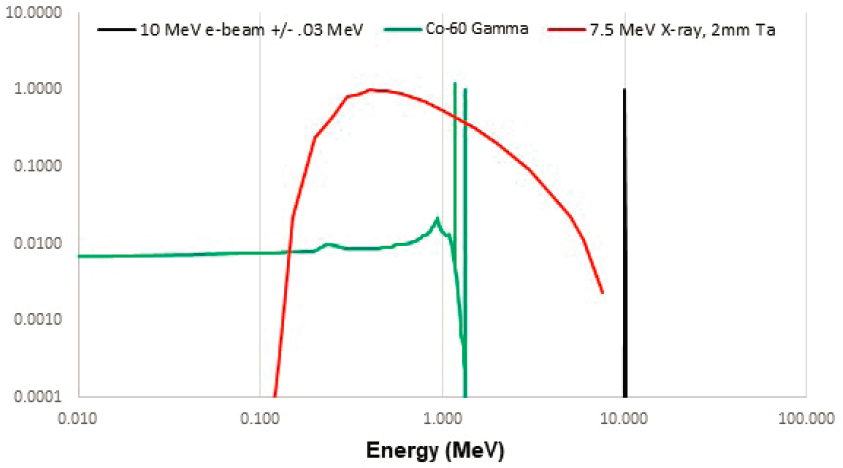Appendix F
Sterilization Using Radiation with Different Modalities
The process of sterilization using gamma ray, x-ray, and electron beam (e-beam) is broadly similar in terms of the transfer of energy and interaction. Gamma rays and x-rays both involve a two-step process of photons interacting with the material, primarily through the Compton effect, and then the created secondary electrons deposit the dose and perform the damage to the biological structure of the bioburden. In the case of e-beam, the initial interaction of photons with the material is omitted, and instead, electrons interact directly with the material. That is, e-beam is the most direct modality of sterilization. This difference between e-beam and gamma or x-ray sources is that it leads to different dose distributions in the product.
X-rays have slightly better penetration than gamma rays from cobalt-60 (see Figure F.1). As with gamma rays, x-rays generate electrons, which are the active factor when interacting with the product to be sterilized. The bremsstrahlung process generates x-rays that are generated for the purpose of sterilization. Typically, 7.5-MeV electrons are directed onto a dense, high-Z material such as tantalum. As the electrons are scattered by the target material atoms, a broad spectrum of x-rays is produced (see Figure F.2). The bremsstrahlung process is very inefficient at 7.5 MeV; only 10–15 percent of the electron energy is converted to x-rays. The rest is dissipated as heat in the target. Therefore, to generate 15 kW of x-ray power, approximately 120 kW of electron beam power is required. A megacurie of cobalt-60 releases approximately 15 kW of photon energy.
E-beam accelerators used in sterilization are typically in the 50- to 80-kW range, which is equivalent to 3 to 5 MCi (111 to 185 GBq) of cobalt-60. The dose rate of an e-beam can be as high as 20 MGy/hr allowing the processing of a box or carton of product within tens of seconds. The throughput of an e-beam facility can be designed to be comparable to that of a gamma facility.
One parameter that may cause a difference in the response of a material to the three radiation modalities for sterilization is the dose rate. A gamma facility typically delivers approximately 10 kGy/hr. For a typical sterilization prescription (25 kGy) this means that a device must remain in the irradiation chamber for 2.5–3 hours. The dose rate for an x-ray system can be six times the rate of gamma, resulting in an irradiation time of 20–30 minutes. E-beams can deliver approximately 20 MGy/hr, and products here can be irradiated in seconds. This dose rate variation can be advantageous or disadvantageous depending on the material that is being sterilized. Some undesired reactions in materials may not have time to develop at higher dose rates, improving their ability to tolerate irradiation. However, 25 kGy in water causes a 6°C increase in temperature. This could be higher in certain areas of a product depending on variations in density and other geometrical factors. A sharp temperature increase in a short period of time could be a concern or it could be more tolerable than spending 2–3 hours in the elevated temperature environment of a typical cobalt-60 irradiator.

NOTES: Data are for water (1 g/cm3). X-ray data are for 7.5 MeV electrons on a bremsstrahlung target.
SOURCE: Fermi National Accelerator Laboratory.

NOTES: The electron beam curve includes a 30-keV width, which is readily achievable by accelerator sources. The spectrum from that was then attenuated by 2 mm of tantalum to represent self-absorption in the bremsstrahlung target.
SOURCE: Fermi National Accelerator Laboratory.


